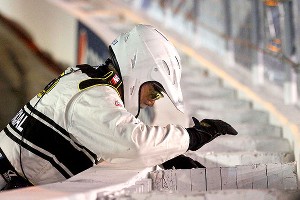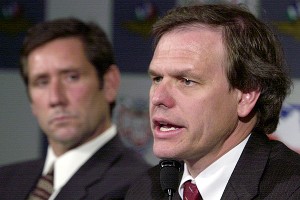Famed racing safety engineer turns eye to football
Sicking says the current design of football helmets can be improved greatly with proper testing, along with state-of-the-art materials and engineering standards.
So who is Dr. Sicking and why should we believe him? Sicking, who works at the University of Alabama-Birmingham, is a nationally recognized engineering professor.
His design and development of the SAFER barrier was a renaissance for auto racing. SAFER stands for Steel And Foam Energy Reduction. The barrier is a collapsible wall used by all major speedways today.
Sicking says a radically different helmet design, based on the same energy-reducing engineering principles as the SAFER barrier, is coming. And he honestly admits financial gain is possible to whichever group of scientists perfects the design first.
He has some engineers working on the project at UAB, but they aren't alone.
"You can hardly throw a rock at a university without hitting someone who is working on this helmet problem," Sicking said. "Engineers are looking at [football] impact videos wherever they can get them."
Sicking said he knows engineering teams at MIT and the University of Nebraska, along with his team at UAB, are working on revolutionary helmet changes.
There is a race nationally among some of the top engineers to see who gets the contractual approval to redesign football helmets.
"As I often have said about road safety devices, this one is in serious need of the next generation," Sicking said of helmet design. "The same was true in auto racing. And we're not there yet on the helmets, but we're close."
 |
| The SAFER Barrier helped revolutionize safety in racing. A decade after it began to be adopted throughout racing, one of its chief designers — engineer Dean Sicking — is turning his attention to football helmets |
| Jason Smith/Getty Images |
Sicking said he hasn't spoken to anyone with the NFL, but NFL spokesman Greg Aiello said the league has a team of scientists that will evaluate new helmet designs.
"Dr. Kevin Guskiewicz chairs a subcommittee on equipment for the NFL's Head, Neck and Spine Committee," Aiello said. "The subcommittee is inviting proposals of new technologies and materials for review by a panel of engineers. It will then make decisions regarding testing through a series of laboratories, located primarily at the universities."
Sicking firmly believes the problem with concussions and brain trauma can be greatly reduced if helmets are radically changed.
In Sicking's view, the helmet's flaws are similar to the problem that major speedways had 10 years ago — a hard outer shell. Tracks had concrete walls as the stopping point for an impact. The hard outer shell of a football helmet presents the same problem, he said.
Everyone in motor sports believes the SAFER barrier, along with other key changes, has saved countless lives over the last decade and greatly reduced the chances of a serious injury for drivers.
No NASCAR driver has lost his life in an event since the barrier became mandatory for all NASCAR tracks. Dale Earnhardt, who was killed in a crash on the last lap of the 2001 Daytona 500 when his car slammed head-on into a concrete barrier, is the last NASCAR driver to lose his life in a race.
The SAFER barrier is a wall of hollow steel tubing with foam padding in front of it, which is placed in front of concrete walls that surround race tracks. The barrier bends at impact, absorbing most of the G-forces when a race car hits the wall.
Sicking's work on impact management, while teaching at the University of Nebraska, also has led to dozens of safety improvements on public highways.
It's all about proper energy absorption. From a physics standpoint, Sicking said the rigid outer shell of a helmet doesn't work well for absorbing the energy of an impact between two objects.
"The helmet shell itself needs to absorb more energy," Sicking said. "As it is now, whatever energy that impacts the shell is taken at the end of the impact, so it's not dissipating any energy. The shell needs to be made out of a different material. It needs to be less elastic."
The definition of elastic: resuming its original shape after being stretched or expanded.
In energy-impact situations, that's not good. If something quickly returns to its original shape, the energy is not dissipated.
"The helmet shell doesn't effectively reduce the G-force impact in a significant way," Sicking said. "What you would like to have is a helmet that flexes a little more and restores itself more slowly.
Sicking said the current helmet design restores its shape in a matter of milliseconds, maybe five or six milliseconds.
"You need a material that restores its shape in about half a second," Sicking said. "The more time it takes the shell to restore its shape, the safer it becomes."
In layman's terms, the longer it takes for the shell to bend, the more energy the device absorbs, which means less energy is transferred to a player's head and brain.
 |
| Dean Sicking — along with former Indianapolis Motor Speedway and Indy Racing League CEO Tony George, left — was instrumental in bringing so-called "soft walls" to racing. All U.S. speedways that host IndyCar and NASCAR's top three series now have them. |
| AP Photo/Darron Cummings |
"And that will require a change of material to the shell," Sicking said, "a more energy-absorbing material."
Sicking is hesitant to say exactly what material he would use in the helmet shell, because he doesn't want competing engineers and scientists to steal his ideas.
"But everyone knows you have to put some compliance [cushioning] in the helmet shell itself," Sicking said. "That's part of it, just like we put compliance into the [SAFER] barrier for racing. It extends the duration of the impact, which reduces the G-load. Anything you can do to extend the duration [of the impact motion] is a win."
Sicking tends to get extremely technical in his descriptions, but here's the point: Make every part of the helmet crush at impact as much as possible so the brain doesn't absorb the energy.
"The way [helmets] are designed now, the G-force goes through the roof," Sicking said. "It's not absorbing enough energy with the way it's constructed. So the G-force applied to the brain goes way up.
"The design needs to reach the threshold crush force, but then go flat. The G-force needs to be constant over a longer period of time. You have to extend the impact as much as you can to make the foam work."
If the shell has more give to it, Sicking said, the padding inside is more effective at reducing energy and eliminating injury.
"The padding inside the helmets is helping if you put some effort into designing it," Sicking said. "That's an easy fix. Anybody with a reasonable understanding of energy management can do it."
Sicking said the foam in the helmets now works in a counterproductive fashion.
"In the SAFER barrier, the foam is designed to develop a force that decelerates the car before you get to the threshold that injures people," Sicking said. "It absorbs impact for a significant period where the force doesn't go up anymore.
"It keeps the G-loading below the level where people get hurt. You could adjust the foam padding inside the helmet in the same way. That will get you a third of the way or halfway to where you need to be."
But Sicking said it's a redesign to the outer shell of the helmets that will make the biggest difference.
Some youth football leagues are using an inflatable device over the helmet to absorb energy. Sicking said it's basically the right idea, but making the outer shell too soft can cause other problems.
"Our approach is a little different," Sicking said. "There are drawbacks to the air-cushion idea. You can't just willy-nilly start making the shell of the helmets soft. They will interlock as one helmet contacts another one, a cup-and-saucer type of thing. The helmets wouldn't slide relative to each other, which could result in broken necks."
The same type of concerns were expressed about collapsible walls in auto racing. People said it wouldn't work because it would catch the cars, causing them to stick to the barrier and turn them. While the SAFER barrier moves, it still is a comparatively hard outer shell. The same would be true of a new outer shell on helmets.
Riddell, which is the official helmet manufacturer for the NFL, released a statement regarding Sicking's thoughts:
"While we are unfamiliar with Dr. Sicking's proposed helmet design developments, Riddell is always seeking to innovate, and to find new ways to improve our helmets and reduce the forces of impacts that athletes experience playing football. For example, Riddell's latest offerings (Riddell 360 and Riddell Revolution Speed) have been shown to be top performers in this area. At Riddell, improving athlete protection is the foundation of our company, and we are committed to designing and manufacturing the most protective equipment for all football players."
The main point for Sicking is that helmet design can be greatly improved, just as concrete walls at racetracks were greatly improved through the SAFER barrier.
The barrier revolutionized auto racing safety. Sicking believes the same concepts for helmets can revolutionize safety in football. ESPN.com